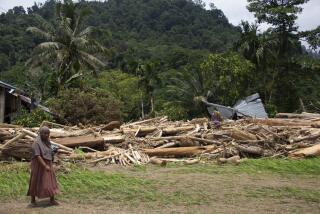Sawing Up the Future
- Share via
Driven by the desperation of poverty, millions of people in Africa, Asia and Latin America are devastating the forests of their nations faster than replacement trees can begin to grow, converting once fertile fields to deserts, eroding plateaus and hillsides, silting up reservoirs that once promised long-lasting supplies of irrigation water and risking global climate changes. By every measure, disaster is developing.
From despair, however, new hope is emerging. Experts have concluded that the deterioration of the tropical forests can be arrested and ultimately reversed. They have assembled a catalogue of successes to prove their point. And they have drawn a detailed plan for action to begin the long and costly process.
There is a major uncertainty, nevertheless. That uncertainty has to do with political commitment and with funds. Without a commitment by leaders of each of the 58 most affected nations, and without a willingness of donors to double their present appropriations for forestry assistance, there can be no hope of ultimately reversing the ravaging deforestation.
The extraordinary opportunity to do something has emerged, not by coincidence, in the midst of the International Year of the Forest, an observation sponsored by the United Nations Food and Agriculture Organization. The plan of action was drawn by nine international experts, sponsored by the World Resources Institute in Washington. It has now been endorsed by the Ninth World Forestry Congress held last month in Mexico City. High officials at major development agencies, including the World Bank, the U.N. Development Program and U.S. Agency for International Development are already reviewing the recommendations even though the final report of the action program will not be released until Oct. 10.
Every element of support will be required. Doubling of support will mean, in sum, raising $800 million a year instead of the present funding of $400 million. In the wider development context, that means increasing forestry funds from about 1.5% of all development assistance to 3% over the next five years. And that will be just the beginning.
But few programs offer the possibility of addressing basic food, energy and development problems of masses of people so directly and effectively. And few problems raise such global risks for all peoples if they are neglected, left to run their course of devastation.
Among the most urgent problems is assuring a permanent, renewable source of fuel wood, the basic energy source for almost half the people on earth. About 80% of all the wood harvested in the Third World goes for fuel. Already, demand is running far ahead of supply. Hundreds of thousands are now reduced to one hot meal a day because of wood shortages. Some villagers devote 20 hours a week to the search for firewood, forced to forage farther and farther afield as forests are eliminated. Erosion of deforested slopes and fields compounds the problem of food supply. And the diversion of dung to fuel instead of fertilizer further exacerbates the food shortages.
In other nations, rich resources of wood are being left untapped for lack of appropriate management and development programs, or priceless forests are being cleared to expose substandard soil for food production better done elsewhere. Each year, forests equal in area to Pennsylvania are being torn out, with incalculable consequences for the future. The risks are already apparent in the arid gullies of the Ethiopian highlands, in the destroyed watersheds of Central America and the Andean and Himalayan foothills, in the Loess Plateau of China, where 250,000 acres of once fertile land are now a wasteland.
The days ahead will be critical in determining whether the challenge will be met, whether the opportunity will be seized. Foreign aid officials from 14 nations, including the United States, and the major international development agencies will meet at The Hague on Nov. 20 to decide whether to proceed. There is optimism, but not yet dollars, to support the activation of an initial five-year program that could, above all, create teams of barefoot foresters and extension workers to implement a rapidly expanding forest rescue program in succeeding years.
These are encouraging signs. They indicate an understanding that the emergency is one shared by all who inhabit the world, for each will in some way be affected, for better or worse. There seems to be a growing understanding that there will never be a better time and that there may never be another time.
More to Read
Sign up for Essential California
The most important California stories and recommendations in your inbox every morning.
You may occasionally receive promotional content from the Los Angeles Times.












